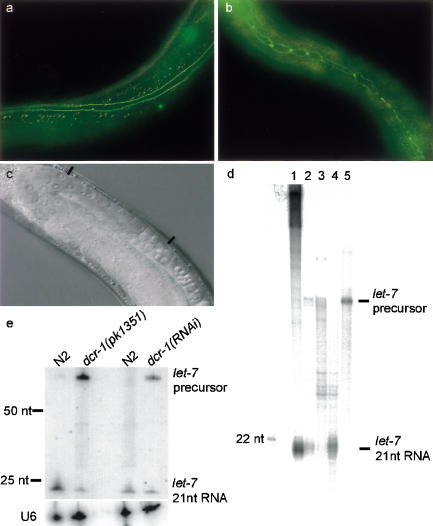Figure 3.
(a) The wild-type pattern of jam-1::gfp staining in seam cells in adult animals. The seam cells have fused, and no individual cells can be recognized. (b) In the dcr-1 deletion mutant, the seam cells of the adult animal have failed to fuse and have undergone an additional round of cell division. (c) An animal is presented that contains a high copy number hsp::dcr-1 transgene (see Materials and Methods). The animal is sterile owing to the absence of oocytes, similar to a lin-41 knockout phenotype. The region where the oocytes should be is located between the two black bars. (d) Dicer converts the let-7 double-stranded precursor into 21-nt RNA molecules in vitro. Radiolabeled let-7 precursor RNA (Drosophila sequence; Pasquinelli et al. 2000; shown in lane 5) was incubated with Drosophila embryo extract (lane 2), dicer preimmune precipitate (lane 3), and dicer immune precipitate (lane 4). (Lane 1) A control reaction with 500-bp dsRNA. (e) A Northern blot on which RNA from wild-type and mutant animals is probed for let-7; U6 was used for a loading control. (Lanes 1,2) RNA from L4-stage wild-type and dcr-1(pk1351) homozygous mutant animals, respectively. The processed let-7 signal drops 10-fold (corrected for loading) in the dcr-1 mutant population, and the longer let-7 precursor RNA accumulates. We find a similar result (twofold reduction of the processed let-7) when we inhibit dcr-1 by RNAi, as shown in lanes 3 and 4; the RNA in these two lanes was isolated from adult animals.

